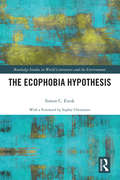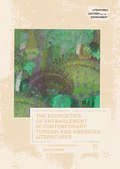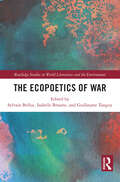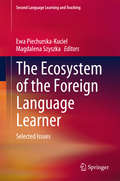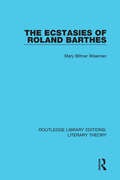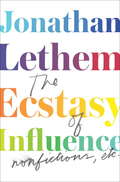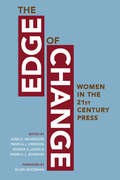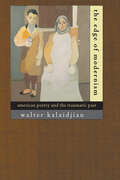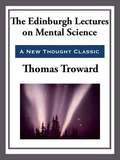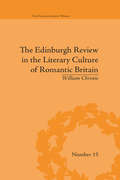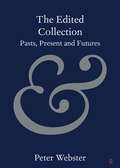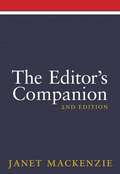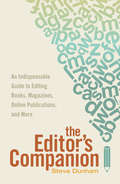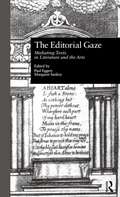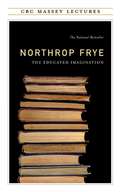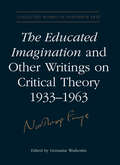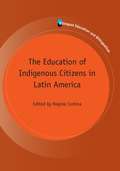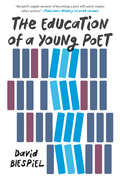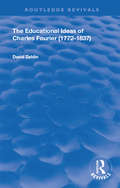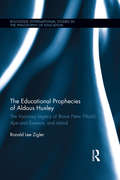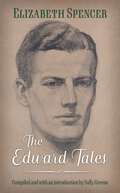- Table View
- List View
The Ecophobia Hypothesis (Routledge Studies in World Literatures and the Environment)
by Simon C. EstokThe Ecophobia Hypothesis grows out of the sense that while the theory of biophilia has productively addressed ideal human affinities with nature, the capacity of “the biophilia hypothesis” as an explanatory model of human/ environment relations is limited. The biophilia hypothesis cannot adequately account for the kinds of things that are going on in the world, things so extraordinary that we are increasingly coming to understand the current age as “the Anthropocene.” Building on the usefulness of the biophilia hypothesis, this book argues that biophilia exists on a broader spectrum that has not been adequately theorized. The Ecophobia Hypothesis claims that in order to contextualize biophilia (literally, the “love of life”) and the spectrum on which it sits, it is necessary to theorize how very un-philic human uses of the natural world are. This volume offers a rich tapestry of connected, comparative discussions about the new material turn and the urgent need to address the agency of genes, about the complexities of 21st century representations of ecophobia, and about how imagining terror interpenetrates the imagining of an increasingly oppositional natural environment. Furthermore, this book proposes that ecophobia is one root cause that explains why ecomedia—a veritably thriving industry—is having so little measurable impact in transforming our adaptive capacities. The ecophobia hypothesis offers an equation that determines the variable spectrums of the Anthropocene by measuring the ecophobic implications and inequalities of speciesism and the entanglement of environmental ethics with the writing of literary madness and pain. This work also investigates how current ecophobic perspectives systemically institutionalize the infrastructures of industrial agriculture and waste management. This is a book about revealing ecophobia and prompting transformational change.
The Ecopoetics of Entanglement in Contemporary Turkish and American Literatures
by Meliz ErginThis book foregrounds entanglement as a guiding concept in Derrida's work and considers its implications and benefits for ecocritical thought. Ergin introduces the notion of "ecological text" to emphasize textuality as a form of entanglement that proves useful in thinking about ecological interdependence and uncertainty. She brings deconstruction into a dialogue with social ecology and new materialism, outlining entanglements in three strands of thought to demonstrate the relevance of this concept in theoretical terms. Ergin then investigates natural-social entanglements through a comparative analysis of the works of the American poet Juliana Spahr and the Turkish writer Latife Tekin. The book enriches our understanding of complicity and accountability by revealing the ecological network of material and discursive forces in which we are deeply embedded. It makes a significant contribution to current debates on ecocritical theory, comparative literature, and ecopoetics.
The Ecopoetics of War (Routledge Studies in World Literatures and the Environment)
by Sylvain Belluc, Isabelle Brasme, and Guillaume TanguyThe Ecopoetics of War explores the interrelationality of human and nonhuman entities in the context of conflict, as recorded in literature and culture. This collection of essays demonstrates the specific and fertile role of literature in representations of war, as it foregrounds the manifold ways in which the borders between human and nonhuman—including flora,fauna, and technology—become porous, thus questioning traditional onto-epistemological and ethical categories.Bringing together British, American, and postcolonial studies, The Ecopoetics of War covers a variety of historical periods, geographical areas, and literary genres. Interdisciplinary in its outlook, it intertwines war studies, ecocriticism, literary theory, philosophy, and cultural studies. By analyzing the stylistic and discursive strategies devised by writers to translate the sensory experience of the battlefield, the contributors shed light on the unique capacity of literature to foreground the entanglement of human and nonhuman in the context of armed conflict, and thus unveil an “ecopoetics of war.”This collection will interest scholars of literature, specialists of war studies and ecocriticism, and any reader interested in such issues such as ecowar, ecocide, the Anthropocene, or environmental justice. It can inspire interdisciplinary teaching or research projects, especially in the current context of global environmental crisis.
The Ecosystem of the Foreign Language Learner
by Ewa Piechurska-Kuciel Magdalena SzyszkaThis volume examines selected aspects of the foreign language learning process from an ecological perspective, adopting a holistic view on complex interrelations among and within organisms (L2 language learners) and their milieus (family, school and society). First of all, the personal ecosystem of the learner is taken into consideration, whereby two powerful influences are intertwined: cognitive and affective aspects. The learning space formed by the individual is largely shaped by their affective states coexisting in conjunction with their cognitive processes. Moreover, this specific space is also modified by a wider array of other personal ecosystems or those of cultures. Hence, the ecosystem of the foreign language learner is also subject to influences coming from sociocultural leverage that can be represented by people they know, like parents and language teachers, who can both directly and indirectly manipulate their ecosystem. At the same time other important forces, such as culture as a ubiquitous element in the foreign language learning process, also have the power to shape that ecosystem. Accordingly, the book is divided into three parts covering a range of topics related to these basic dimensions of foreign language acquisition (the cognitive, affective and socio-cultural). Part I, Affective Interconnections, focuses on the body of original empirical research into the affective domain of not only L2 language learners but also non-native language teachers. Part II, Cognitive Interconnections, reports on contributions on language learners' linguistic processing and cognitive representations of concepts. The closing part, Socio-cultural Interconnections, provides new insights into language learning processes as they are affected by social and cultural factors.
The Ecstasies of Roland Barthes (Routledge Library Editions: Literary Theory #26)
by Mary Bittner WisemanIn this book, first published in 1989, Mary Bittner Wiseman interprets Roland Barthes’s experiments as efforts to reposition the human subject with respect to language and to time in order to let the subject escape from the language of a particular culture and the present time. With her insistent pushing against the boundaries of our standard academic assumptions, Mary Bittner Wiseman succeeds in interpreting Barthes’s effort to join the traditional and the new. This title will be of interest to students of literature and philosophy.
The Ecstasies of Roland Barthes (Routledge Library Editions: Literary Theory)
by Mary Bittner WisemanIn this book, first published in 1989, Mary Bittner Wiseman interprets Roland Barthes’s experiments as efforts to reposition the human subject with respect to language and to time in order to let the subject escape from the language of a particular culture and the present time. With her insistent pushing against the boundaries of our standard academic assumptions, Mary Bittner Wiseman succeeds in interpreting Barthes’s effort to join the traditional and the new. This title will be of interest to students of literature and philosophy.
The Ecstasy of Influence
by Jonathan LethemWhat's a novelist supposed to do with contemporary culture? And what's contemporary culture supposed to do with novelists? InThe Ecstasy of Influence, Jonathan Lethem, tangling with what he calls the 'white elephant' role of the writer as public intellectual, arrives at an astonishing range of answers. A constellation of previously published pieces and new essays as provocative and idiosyncratic as any he's written, this volume sheds light on an array of topics from sex in cinema to drugs, graffiti, Bob Dylan, cyberculture, 9/11, book touring and Marlon Brando. Then there are investigations of a shelf's worth of his literary models and contemporaries: Norman Mailer, Philip K. Dick, Bret Easton Ellis, James Wood, and others. And, writing about Brooklyn, his father, and his sojourn through two decades of writing, one of the greats of contemporary American literature sheds an equally strong light on himself. Funny and unfettered,The Ecstasy of Influencesimmers with direct challenges to conventional wisdom and deep insights into the kaleidoscopic nature of artistic vision, the primacy of the writer in the cultural marketplace, and the way the author's own experiences have fuelled his creative passions.
The Edge of Change: Women in the Twenty-First-Century Press
by Deb Price Ellen Goodman Margaret Sullivan Kathleen Carroll Dorothy Butler Gilliam Pamela J. Creedon Helen E Fisher Catalina Camia Paula Lynn Ellis Sharon Grigsby Carol Guzy Kirsten Hampton Cathy Henkel Pamela J. Johnson Jane Kirtley Jan Leach Caroline Little Wanda S. Lloyd Arlene Notoro Morgan June O. Nicholson Geneva Overholser Marty Petty Donna M Reed Sandra Mims Rowe Peggy Simpson Julia Wallace Keven Ann WilleyContaining nearly three dozen original essays penned by the nation's leading newspaper journalists, editors, and executives, this book advances current discussions regarding women in journalism. Surveying the past quarter century, the book's contributors highlight the unprecedented influence American women have had on the news industry, especially newspapers, and look ahead to the future for women in news. Acclaimed anthropologist and author Helen E. Fisher adds her perspective in examining the role of women across millennia and how the talents of women are changing social and economic life in this global age. Prominent female voices in journalism provide critical perspectives on the challenges women face in today's news organizations, such as connecting with diverse audiences, educating readers about international issues and cultures, maintaining credibility, negotiating media consolidation and corporate pressures, and overcoming the persistent barriers to professional advancement. A powerful and complex assessment of how women are transforming the news industry, The Edge of Change explores how the news industry might implement further reforms aimed at creating a more inclusive journalistic community. Contributors are Catalina Camia, Kathleen Carroll, Pamela J. Creedon, Paula Lynn Ellis, Helen E. Fisher, Dorothy Butler Gilliam, Ellen Goodman, Sharon Grigsby, Carol Guzy, Kirsten Scharnberg Hampton, Cathy Henkel, Pamela J. Johnson, Jane Kirtley, Jan Leach, Caroline Little, Wanda S. Lloyd, Arlene Notoro Morgan, June O. Nicholson, Geneva Overholser, Marty Petty, Deb Price, Donna M. Reed, Sandra Mims Rowe, Peggy Simpson, Margaret Sullivan, Julia Wallace, and Keven Ann Willey.
The Edge of Modernism: American Poetry and the Traumatic Past
by Walter KalaidjianIn The Edge of Modernism, Walter Kalaidjian explores American poetry on genocide, the Holocaust, and total war as well as on postwar social antagonisms, racial oppression, and domestic violence. By asking what it means for traumatic memory to have agency in the American verse tradition, Kalaidjian creates an original historical account of how American poets became witnesses, often unconsciously, to modern extremity. Combining psychoanalytic theory and cultural studies, this intense, sweeping account of modern poetics analyzes the ways in which literary form gives testimony to the trauma of twentieth-century history. Through close readings of well-known and less familiar poets—among them Langston Hughes, Countee Cullen, Claude McKay, Edwin Rolfe, Sylvia Plath, Adrienne Rich, Peter Balakian, Rachel Blau DuPlessis, Anne Sexton, and Anthony Hecht—Kalaidjian discerns the latent "edge" of modern trauma as it cuts through the literary representations, themes, and formal techniques of twentieth-century American poetics. In this way, The Edge of Modernism advances an innovative and dynamic model of modern periodization.
The Edge of the Swamp: A Study in the Literature and Society of the Old South
by Louis D. Rubin Jr.The flowering of literary imagination known as the American Renaissance had few roots in the South. While Hawthorne, Emerson, Melville, Thoreau, and Whitman were creating a body of work that would endure, the only southern writer making a lasting contribution was Edgar Allan Poe. This failure on the part of antebellum southern writers has long been a subject of debate among students of southern history and literature. Now one of the region's most distinguished men of letters offers a cogently argued and gracefully written account of the circumstances that prevented early southern writers from creating transcendent works of art.Louis D. Rubin, Jr., brings forty years of critical integrity and imaginative involvement with the history and literature of the South to his informal inquiry into the foundations of the southern literary imagination. His exploration centers on the lives and works of three of the most important writers of the pre-Civil War South: Poe, William Gilmore Simms, and Henry Timrod.In a close and highly original reading of Poe's poetry and fiction, Rubin shows just how profoundly growing up in Richmond, Virginia, influenced that writer. The sole author of the Old South whose work has endured did not use southern settings or concern himself with his region's history or politics. Poe was, according to Rubin, in active rebellion against the middle-class community of Richmond and its materialistic values.Simms, on the other hand, aspired to the plantation society ideal of his native Charleston, South Carolina. He was not the most devoted and energetic of southern writers and one of the country's best-known and most respected literary figures before the Civil War. Rubin finds an explanation for much of the lost promise of antebellum southern literature in Simms's career. Here was a talented man who got caught up in the politically obsessed plantation community of Charleston, becoming an apologist for the system and an ardent defender of slavery.Timrod, also a Charlestonian native, was a highly gifted poet whose work attained the stature of literature when the Civil War gave him a theme. He was known as the poet laureate of the Confederacy. Only when his region was locked in a desperate military struggle for the right to exist did he suddenly find his enduring voice.Anyone interested in southern life and literature will welcome his provocative and engaging new look at southern writing from one of the region's most perceptive critics.
The Edible Woman (MAXNotes Literature Guides)
by Jeffrey LilburnREA's MAXnotes for Margaret Atwood's The Edible Woman MAXnotes offer a fresh look at masterpieces of literature, presented in a lively and interesting fashion. Written by literary experts who currently teach the subject, MAXnotes will enhance your understanding and enjoyment of the work. MAXnotes are designed to stimulate independent thought about the literary work by raising various issues and thought-provoking ideas and questions. MAXnotes cover the essentials of what one should know about each work, including an overall summary, character lists, an explanation and discussion of the plot, the work's historical context, illustrations to convey the mood of the work, and a biography of the author. Each chapter is individually summarized and analyzed, and has study questions and answers.
The Edinburgh Lectures on Mental Science
by Thomas TrowardThis anthology is a thorough introduction to classic literature for those who have not yet experienced these literary masterworks. For those who have known and loved these works in the past, this is an invitation to reunite with old friends in a fresh new format. From Shakespeare s finesse to Oscar Wilde s wit, this unique collection brings together works as diverse and influential as The Pilgrim s Progress and Othello. As an anthology that invites readers to immerse themselves in the masterpieces of the literary giants, it is must-have addition to any library.
The Edinburgh Review in the Literary Culture of Romantic Britain: Mammoth and Megalonyx (The Enlightenment World #15)
by William ChristieFrom its first issue, published on the 10th October 1802, Francis Jeffrey's "Edinburgh Review" established a strong reputation and exerted a powerful influence. This is a literary study of the "Edinburgh Review" for over fifty years. It contextualizes the periodical within the culture wars of the Romantic era.
The Edited Collection: Pasts, Present and Futures (Elements in Publishing and Book Culture)
by Peter WebsterEdited collections are widely supposed to contain lesser work than scholarly journals; to be incoherent as volumes, no more than the sum of their parts; and to be less visible to potential readers once published. It is also often taken as axiomatic that those who make decisions in relation to hiring, promotion, tenure, and funding do so agree. To publish in or edit an essay collection is thought to risk being penalised for the format before even a word is read. After examining the origins of this critique, this Element explores the modern history of the edited collection and the particular roles it has played. It examines each component part of the critique, showing that they are either largely unfounded or susceptible of solution. It proposes the edited collection as a model of one possible idea of scholarly community: collaboration, trust, and mutual obligation in pursuit of a wider good.
The Editor Function: Literary Publishing in Postwar America
by Abram FoleyOffering the everyday tasks of literary editors as inspired sources of postwar literary history Michel Foucault famously theorized &“the author function&” in his 1969 essay &“What Is an Author?&” proposing that the existence of the author limits textual meaning. Abram Foley shows a similar critique at work in the labor of several postwar editors who sought to question and undo the corporate &“editorial/industrial complex.&” Marking an end to the powerful trope of the editor as gatekeeper, The Editor Function demonstrates how practices of editing and publishing constitute their own kinds of thought, calling on us to rethink what we read and how.The Editor Function follows avant-garde American literary editors and the publishing practices they developed to compete against the postwar corporate consolidation of the publishing industry. Foley studies editing and publishing through archival readings and small press and literary journal publishing lists as unique sites for literary inquiry. Pairing histories and analyses of well- and lesser-known figures and publishing formations, from Cid Corman&’s Origin and Nathaniel Mackey&’s Hambone to Dalkey Archive Press and Semiotext(e), Foley offers the first in-depth engagement with major publishing initiatives in the postwar United States.The Editor Function proposes that from the seemingly mundane tasks of these editors—routine editorial correspondence, line editing, list formation—emerge visions of new, better worlds and new textual and conceptual spaces for collective action.
The Editor's Companion
by Janet MackenzieAs the knowledge economy takes shape, editors face many challenges. Technology is transforming publishing, text is losing out to graphics, and writing is distorted by cliché, hype and spin. More than ever, editors are needed to add value to information and to rescue readers from boredom and confusion. The Editor's Companion explains the traditional skills of editing for publication and how to adapt them for digital production. It describes the editorial tasks for print and screen publications, from fantasy novels and academic texts to web pages and government documents. It is an essential tool for professional editors, as well as media and publications officers, self-publishers and writers editing their own work. This revised edition features extended coverage of on-screen editing, single-source publishing and digital rights, a comprehensive glossary of editing terms and a companion website developed especially for students that includes editing exercises, expert 'tips' and essential weblinks.
The Editor's Companion: An Indispensable Guide to Editing Books, Magazines, Online Publications, and Mor e
by Steve DunhamExcel at editing! The editor's job encompasses much more than correcting commas and catching typos. Your chief mission is to help writers communicate effectively--which is no small feat. Whether you edit books, magazines, newspapers, or online publications, your ability to develop clear, concise, and focused writing is the key to your success. The Editor's Companion is an invaluable guide to honing your editing skills. You'll learn about editing for: CONTENT: Analyze and develop writing that is appealing and appropriate for the intended audience. FOCUS: Ensure strong beginnings and satisfying endings, and stick with one subject at a time. PRECISE LANGUAGE: Choose the right words, the right voice, and the right tense for every piece. GRAMMAR: Recognize common mistakes in punctuation, parts of speech, and sentence structure--and learn how to avoid them. You'll also find valuable editing resources and checklists, advice on editorial relationships and workflow, and real-life samples of editing with explanations of what was changed and why. The Editor's Companion provides the tools you need to pursue high quality in editing, writing, and publishing--every piece, every time.
The Editorial Gaze: Mediating Texts in Literature and the Arts (Comparative Literature and Cultural Studies #2)
by Paul Eggert Margaret SankeyThis collection of original essays brings international and multidisciplinary perspectives to the problem of how to understand and practice editorial mediation: How does editing alter what it seeks to represent? How does it condition the relationship between texts and readers? The different concerns shared by editors of a variety of genres, literary and otherwise, emerge here as constructive new approaches to the theory and practice of editing are explored. The essays make a concerted attempt to assess the implications of postmodern thought on one of the oldest and most fundamental cultural activities, editing The section on theory covers such important subjects as editorial responsibility, the death of the author, and the nature of the authorial voice. The practice section covers actual editing situations in various literary areas and in musicology, recorded music, and the preservation of oral literature. The multidisciplinary volume will find its readers among students of textual criticism, literature, music, and folklore as well as any readers of postmodern criticism.
The Educated Imagination (The CBC Massey Lectures)
by Northrop Frye"What good is the study of literature? Does it help us think more clearly, or feel more sensitively, or live a better life than we could without it?" Written in the relaxed and frequently humorous style of his public lectures, this remains, of Northrop Frye's many books, perhaps the easiest introduction to his theories of literature and literary education.
The Educated Imagination and Other Writings on Critical Theory 1933-1963
by Northrop Frye Germaine WarkentinIn 1933, Northrop Frye was a recent university graduate, beginning to learn his craft as a literary essayist. By 1963, with the publication of The Educated Imagination, he had become an international academic celebrity. In the intervening three decades, Frye wrote widely and prodigiously, but it is in the papers and lectures collected in this installment of the Collected Works of Northrop Frye, that the genesis of a distinguished literary critic can be seen. Here is Frye tracing the first outlines of a literary cosmology that would culminate in The Anatomy of Criticism (1958) and shapeThe Great Code (1982) and Words with Power (1990). At the same time that Frye garnered such international acclaim, he was also a working university teacher, lecturing in the University of Toronto's English Language and Literature program. In her lively introduction, Germaine Warkentin links Frye's evolution as a critic with his love of music, his passionate concern for his students, and his growing professional ambition. The writings included in this volume show how Frye integrated ideas into the work that would consolidate the fame that Fearful Symmetry (1947) had first established.
The Education of Indigenous Citizens in Latin America
by Regina CortinaThis groundbreaking volume describes unprecedented changes in education across Latin America, resulting from the endorsement of Indigenous peoples' rights through the development of intercultural bilingual education. The chapters evaluate the ways in which cultural and language differences are being used to create national policies that affirm the presence of Indigenous peoples and their cultures within Mexico, Ecuador, Peru, Bolivia and Guatemala. Describing the collaboration between grassroots movements and transnational networks, the authors analyze how social change is taking place at the local and regional levels, and they present case studies that illuminate the expansion of intercultural bilingual education. This book is both a call to action for researchers, teachers, policy-makers and Indigenous leaders, and a primer for practitioners seeking to provide better learning opportunities for a diverse student body.
The Education of a Young Poet
by David Biespiel"Biespiel’s supple memoir of becoming a poet will surely inspire other writers to embrace the bodily character of writing and feel the power and, sometimes, the emptiness of the act of writing poetry." —Publishers Weekly (starred review)The Education of a Young Poet is David Biespiel’s moving account of his awakening to writing and the language that can shape a life. Exploring the original source of his creative impulse—a great–grandfather who traveled alone from Ukraine to America in 1910, eventually settling as a rag peddler in the tiny town of Elma, Iowa—through the generations that followed, Biespiel tracks his childhood in Texas and his university days in the northeast, led along by the ""pattern and random bursts that make up a life."His book offers an intimate recollection of how one person forges a life as a writer during extraordinary times. From the Jewish quarter of Houston in the 1970s to bohemian Boston in the 1980s, from Russia’s Pale of Settlement to a farming village in Vermont, Biespiel remains alert to the magic of possibilities—ancestral journeys, hash parties, political rallies, family connections, uncertain loves, the thrill of sex, and lasting friendships. Woven throughout are reflections on the writer’s craft coupled with a classic coming–of–age tale that does for Boston in the 1980s what Hemingway’s A Moveable Feast did for Paris in the 1920s and Broyard’s Kafka Was the Rage did for Greenwich Village in the 1950s.Restless with curiosity and enthusiasm, The Education of a Young Poet is a singular and universal bildungsroman that movingly demonstrates, "in telling the story of one’s coming into consciousness, all languages are more or less the same."
The Educational Ideas of Charles Fourier: 1772-1837 (Routledge Revivals)
by David ZeldinOriginally published in 1969, this book aims to show that Charles Fourier has much to say that is of interest to modern edcationlists. Fourier hardly ever figures in histories of education because only recent developments in educational practice have shown his ideas to be of topical and practical importance to the schoolteacher and the planner of today. Fourier devised a system of education to suit a self-infulgent, democratic society, in which children's energies could be used in ways which were both socially useful and personally rewarding. He was a pioneer advocate of comprehensive education, so as to establish harmy between classes. He urged vocational training and guidance, so as to establish harmony between men and their work. He devised close links between education and industry, to bring pleasure into both school and work and to integrate the two. He was one of the first to plan social service to the community by children. This prophetic though eccentric writer, sometimes extravagant, often amusing, but always endearing, who has already exerted much influence on socialist theory, deserves to be better known by students of education.
The Educational Prophecies of Aldous Huxley: The Visionary Legacy of Brave New World, Ape and Essence and Island (Routledge International Studies in the Philosophy of Education)
by Ronald ZiglerThe visionary legacy of Aldous Huxley is as relevant today as ever. Huxley possessed a sober understanding of the human condition as well as an inspired vision of the human potential. This volume presents an interdisciplinary examination and appreciation of Aldous Huxley’s three visionary novels – Brave New World (1932), Ape and Essence (1948), and Island (1962) – to reveal the extent to which Huxley’s prognoses into our possible futures was prophetic. The author assesses each novel to reveal the foresights that define our current educational, social, religious, political, and economic institutions, while also exposing our conflicts within those institutions. This volume examines the educational, cultural and technological changes that have shaped our society since Huxley’s work, with special reference to the enduring legacy of educational philosopher John Dewey. It offers profound insights into the educational forces and moral foundations of our society that shape us, both inside and outside of our schools. It is the first of its kind to focus exclusively on all three of Huxley’s visionary novels and detail their relevance to our world today.
The Edward Tales
by Elizabeth SpencerIn conferring upon Mississippi native Elizabeth Spencer (1921–2019) the 2013 Rea Award for the Short Story, the jury said that at the then age of ninety-two, she “has thrived at the height of her powers to a degree that is unparalleled in modern letters.” Over a celebrated six-decade career, Spencer published every type of literary fiction: novels and short stories, a memoir, and a play. Like her best-known work, The Light in the Piazza, most of her narratives explore the inner lives of restless, searching southern women. Yet one mercurial male character, Edward Glenn, deserves attention for the way he insists on returning to her pages. Speaking of Edward in unusually personal terms, Spencer admitted a strong attraction to his type: the elusive, intelligent southern man, “maybe an unresolved part of my psyche.” In The Edward Tales, Sally Greene brings together the four narratives in which Edward figures: the play For Lease or Sale (1989) and three short stories, “The Runaways” (1994), “Master of Shongalo” (1996), and “Return Trip” (2009). The collection allows readers to observe Spencer’s evolving style while offering glimpses of the moral reasoning that lies at the heart of all her work. Greene’s critical introduction helpfully places these narratives within the context of Spencer’s entire body of writing. The Edward Tales confirms Spencer’s place as one of our most beloved and accomplished writers.
